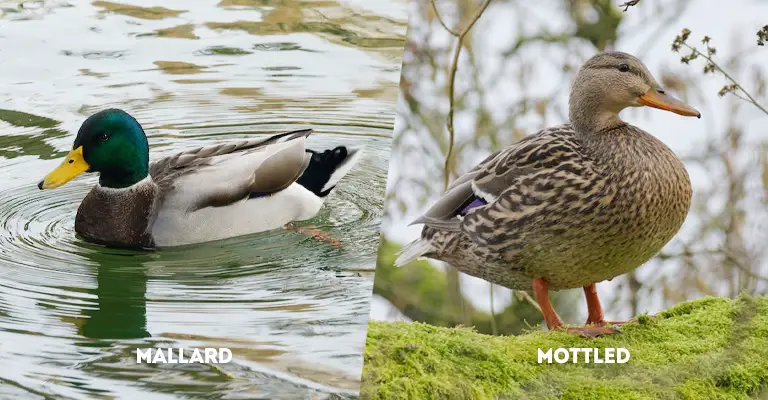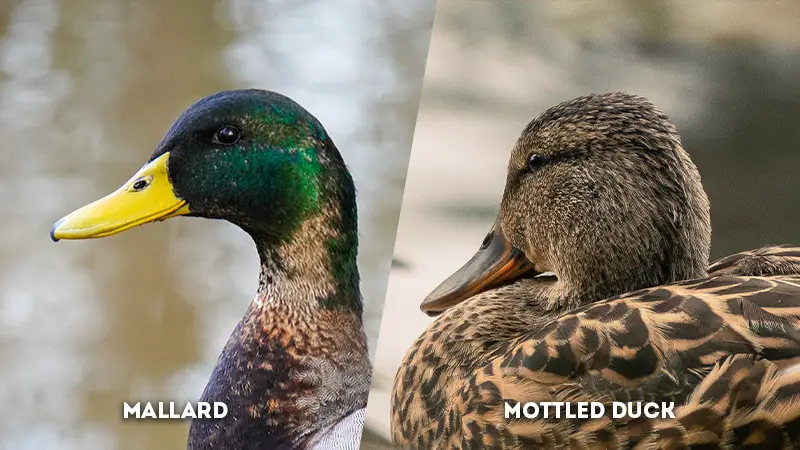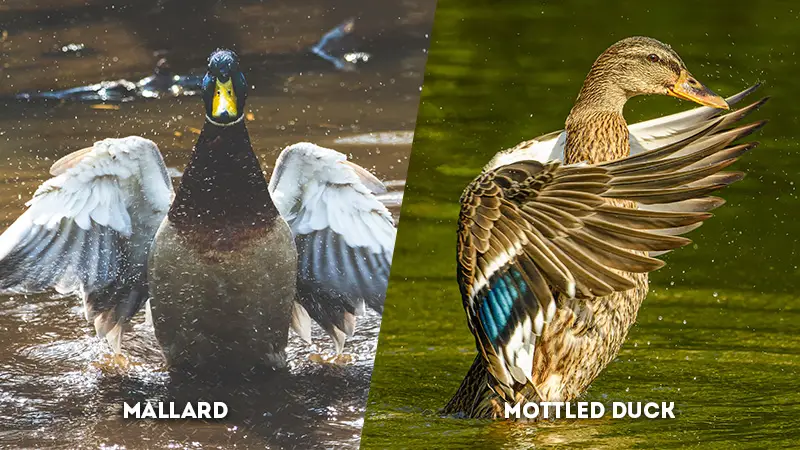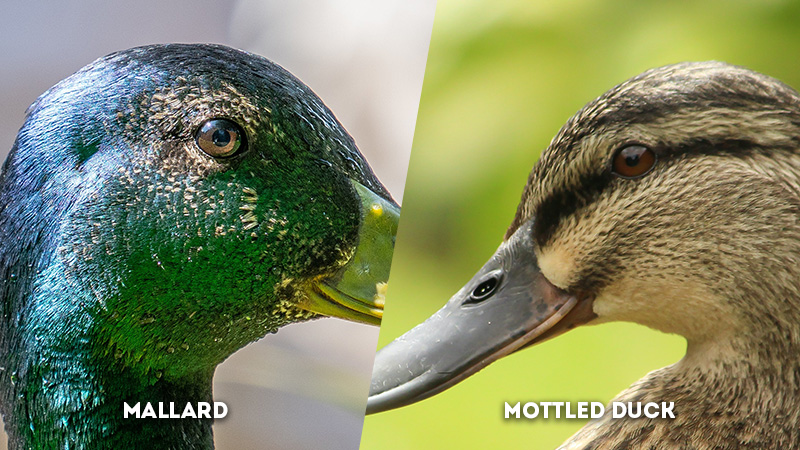In the realm of wetland avifauna, Mallards and Mottled Ducks stand as intriguing examples of species differentiation. These waterfowl exhibit a myriad of distinguishing traits that encompass their appearance, behavior, and habitat preferences.
Delving into their nuanced variations sheds light on the remarkable adaptability and unique roles each species plays within their respective ecosystems.
From plumage distinctions to behavioral adaptations, exploring these differences not only enriches our understanding of avian diversity but also offers insights into the intricate interplay between form and function in the natural world.

Key Differences Between Mallard and Mottled Duck
Here are 25 key differences between the Mallard and Mottled Duck:
Male Head Color

- Mallard: The male Mallard boasts a stunning and easily recognizable glossy green head. This iridescent feature is a hallmark of the species and often draws attention. The vibrant green hue, coupled with the drake’s other distinguishing features, sets the Mallard apart.
- Mottled Duck: In stark contrast, the male Mottled Duck lacks the vivid green head of its Mallard counterpart. Instead, it displays a more subdued brownish head color. This difference in head coloration contributes to the distinctiveness of the Mottled Duck’s appearance.
Female Head Color
- Mallard: Female Mallards exhibit mottled brown head coloration that camouflages well in their natural habitats. This helps protect them and their nests from potential predators, allowing them to blend into their surroundings.
- Mottled Duck: Female Mottled Ducks also display a similarly muted head color, featuring subdued brown shades. This shared characteristic between the sexes further contributes to the Mottled Duck’s less vibrant appearance compared to the Mallard.
Neck Ring

- Mallard: One of the notable features of the male Mallard is its prominent white neck ring. This distinctive ring encircling the neck adds to the bird’s elegance and is easily recognizable in both flight and resting positions.
- Mottled Duck: On the other hand, the Mottled Duck lacks the distinct white neck ring that defines the Mallard. This absence of a visible neck ring is another factor in differentiating between the two species.
Body Coloration
- Mallard: Mallards exhibit a wide range of body coloration, with males showcasing vibrant and varied colors. The male Mallard’s rich brown, gray, and green hues contribute to its visually striking appearance. Females, while more subdued, also display mottled and camouflaging shades.
- Mottled Duck: Mottled Ducks, in both males and females, possess more uniform body coloration. Their plumage is characterized by streaks and mottles that blend in well with their marshy habitats. This consistency in coloration sets them apart from the more varied and vibrant Mallards.
Bill Color
- Mallard: The Mallard’s bill features hues of yellow or orange, adding to its overall colorful appearance. This bill color serves as a visual cue, especially in males, during courtship displays and interactions.
- Mottled Duck: Mottled Ducks possess bills that are typically colored in shades of yellow or olive. This difference in bill coloration is another distinguishing trait that separates them from Mallards.
Bill Pattern
- Mallard: The bill of the Mallard is not only functional but also contributes to its visual allure. Characterized by a distinctive black central stripe, the Mallard’s bill pattern is a striking feature. This pattern serves a practical purpose, helping to identify the species in various settings.
- Mottled Duck: In contrast, the Mottled Duck’s bill lacks the prominent black central stripe observed in the Mallard. The bill exhibits a simpler, more uniform appearance, without the bold contrasting stripe that characterizes its Mallard counterpart.
Tail
- Mallard: The Mallard’s tail is a noteworthy feature, often caught in the distinctive curled position that adds to the drake’s charm. This curled tail is especially apparent during displays and interactions, making the Mallard easily recognizable, even from a distance.
- Mottled Duck: Conversely, the Mottled Duck’s tail lacks the signature curl of the Mallard’s tail. Instead, the tail is straight and uniform, without the pronounced curling observed in Mallards.
Wing Speculum

- Mallard: The iridescent wing speculum of the Mallard is an eye-catching trait, reflecting a dazzling array of blue or purple hues. This speculum stands out during flight and adds to the Mallard’s aesthetic appeal.
- Mottled Duck: On the other hand, the Mottled Duck’s wing speculum lacks the vivid iridescence seen in Mallards. Instead, the speculum tends to display duller shades of blue or green, contributing to the Mottled Duck’s more understated appearance.
Size
- Mallard: Mallards are characterized by their medium size, which places them comfortably between larger and smaller waterfowl species. This size is a part of their adaptability, enabling them to thrive in a range of wetland environments.
- Mottled Duck: Similarly, Mottled Ducks also fall into the medium-sized category among ducks. Their size is comparable to that of Mallards, reflecting a shared ecological niche in their respective habitats.
Habitat
- Mallard: The Mallard boasts a remarkably versatile habitat range, spanning various continents. From North America to Europe and Asia, Mallards are known to inhabit a plethora of wetland environments, adapting to both natural and urban settings.
- Mottled Duck: In contrast, the habitat of the Mottled Duck is more localized, primarily confined to the southeastern United States and parts of Mexico. Their distribution highlights their preference for specific marshy and freshwater habitats.
Distribution
- Mallard: The Mallard’s adaptability is highlighted by its widespread distribution across continents. These ducks can be found in North America, Europe, Asia, and various other regions. Their ability to thrive in diverse environments, from urban ponds to remote lakes, contributes to their ubiquity.
- Mottled Duck: In contrast, the Mottled Duck’s distribution is more localized. They predominantly inhabit the southeastern United States and parts of Mexico. This regional distribution underscores their affinity for specific wetland habitats in their native range.
Hybridization
- Mallard: Mallards are renowned for their propensity to hybridize with other duck species. This hybridization has led to the creation of various hybrid ducks that exhibit a mix of Mallard and other species’ traits. The genetic interchangeability of Mallards contributes to their remarkable adaptability.
- Mottled Duck: Mottled Ducks are known to hybridize with Mallards, resulting in hybrid offspring with intermediate features. These hybrids can exhibit a blend of Mottled Duck and Mallard characteristics, showcasing the potential for genetic intermingling between these two species.
Voice
- Mallard: Mallards are recognized by their distinctive vocalizations, which include quacks and whistles. Their calls serve various purposes, including communication between individuals and attracting potential mates during the breeding season.
- Mottled Duck: Mottled Ducks also possess vocalizations that contribute to their interactions and communication. While their calls may not be as recognizable as the Mallard’s quacks, they play a crucial role in conveying information within their social groups.
Breeding Habits
- Mallard: Mallards often display breeding behaviors in urban environments, nesting in a variety of sites, including parks and gardens. This adaptability to human-altered landscapes is a testament to their flexibility and ability to exploit available resources.
- Mottled Duck: Mottled Ducks tend to prefer more natural breeding settings, often nesting in marshy areas, reed beds, and other wetland habitats. Their breeding behavior aligns with their affinity for more pristine environments.
Nesting Behavior
- Mallard: Mallards are known for their diverse nesting behaviors. They may build nests in concealed spots, such as under shrubs or in tall grass, often away from water bodies. This strategy helps protect their nests from potential predators.
- Mottled Duck: Mottled Ducks also exhibit distinct nesting behaviors. They tend to build their nests in marshy vegetation, often close to water sources. This choice of nesting sites aligns with their natural habitat preferences.
Behavior
- Mallard: Mallards are recognized for their sociable and gregarious behavior. They often congregate in groups, displaying social interactions both during feeding and resting. This behavior promotes group cohesion and aids in protecting the flock from potential predators.
- Mottled Duck: Mottled Ducks, in contrast, generally exhibit less sociable behavior. They tend to be more solitary and are often seen foraging alone or in smaller groups. This behavior aligns with their preference for less crowded, quieter environments.
Migratory Patterns
- Mallard: Mallards showcase diverse migratory patterns depending on their populations. While some are migratory and undertake significant journeys between breeding and wintering grounds, others are more sedentary and remain in their home regions year-round.
- Mottled Duck: Mottled Ducks often display a more resident or short-distance migratory pattern. Many populations of Mottled Ducks are considered non-migratory or undertake only limited movements to find suitable habitats within their preferred range.
Bill Shape
- Mallard: The Mallard’s bill is characterized by its broad and flat shape, well-suited for dabbling and filtering food from water. This bill morphology allows them to consume a varied diet, including aquatic plants, insects, and small aquatic animals.
- Mottled Duck: Mottled Ducks possess a slightly narrower and more pointed bill compared to the Mallard. This bill shape indicates their adaptation to a diet primarily consisting of plant material, insects, and small aquatic creatures found in their marshy habitats.
Eye Stripe

- Mallard: Male Mallards sport a distinctive white eye stripe that contrasts with their iridescent green head. This feature contributes to their striking appearance, especially during courtship displays.
- Mottled Duck: Mottled Ducks lack the prominent white eye stripe observed in male Mallards. Instead, their eye region appears more subdued and lacks the bold contrast seen in their Mallard counterparts.
Bill Spot
- Mallard: Mallards often possess a noticeable orange or yellow bill spot at the base of their bills. This spot can serve as a visual cue during interactions and courtship displays, contributing to their intricate communication rituals.
- Mottled Duck: Mottled Ducks typically lack the distinct bill spot found in Mallards. Their bills exhibit a more uniform coloration without the vivid spotting seen in the Mallard species.
Eye Color
- Mallard: The eye color of Mallards is typically dark, reflecting a deep brown or black hue. This coloration complements their vibrant plumage and contributes to their overall striking appearance.
- Mottled Duck: Mottled Ducks also possess dark eye color similar to Mallards. The shared trait of dark eye color emphasizes their focus on visual cues in their environments, aiding them in detecting predators and potential food sources.
Head Shape
- Mallard: Mallards exhibit a roundish head shape that is particularly noticeable in both sexes. This rounded head contributes to their iconic and recognizable profile, especially in the drake with its vivid green head.
- Mottled Duck: Mottled Ducks, while displaying some variation in head shape, tend to have a slightly elongated head compared to Mallards. This subtle difference in head shape adds to their unique appearance and sets them apart from Mallards.
Body Shape
- Mallard: Mallards are known for their stocky body shape, characterized by a relatively compact and well-built frame. This body shape contributes to their buoyancy in water and agility in the air.
- Mottled Duck: Mottled Ducks exhibit a slightly slenderer body shape compared to the more robust Mallards. This streamlined body shape aligns with their habitat preferences in marshy and watery environments.
Leg Color

- Mallard: Mallards possess vibrant orange legs that provide a splash of color against their plumage. This leg coloration is especially noticeable in flight and adds to their visual appeal.
- Mottled Duck: Mottled Ducks, in contrast, often have duller yellow or olive-colored legs. This more subdued leg coloration complements their overall muted appearance and helps them blend into their preferred marshy habitats.
Foraging Behavior
- Mallard: Mallards are dabbling ducks that engage in a variety of foraging behaviors. They dabble at the water’s surface, tip their bodies to reach underwater vegetation, and even upend themselves to feed on aquatic plants and small organisms.
- Mottled Duck: Mottled Ducks share similar foraging behaviors with Mallards, engaging in dabbling and upending to access food. Their foraging habits reflect their adaptations to wetland habitats rich in aquatic resources.
Mallard Vs Mottled Duck: Comparison Table
| Feature | Mallard | Mottled Duck |
|---|---|---|
| Male Head Color | Glossy green | Brownish (no bright green) |
| Female Head Color | Mottled brown | Subdued brown |
| Neck Ring | Prominent white | No distinct white neck ring |
| Body Coloration | Vibrant, varied colors | Consistent, subdued tones |
| Bill Color | Yellow or orange | Yellow or olive |
| Bill Pattern | Black central stripe | No prominent stripe |
| Tail | Curled black | Straight, uniform |
| Wing Speculum | Iridescent blue or purple | Duller blue or green |
| Size | Medium | Medium |
| Habitat | Worldwide wetlands | Southeastern U.S. and Mexico |
| Distribution | Widespread | More localized |
| Hybridization | Can hybridize with others | Hybridizes with Mallards |
| Voice | Quacks and whistles | Quacks and calls |
| Breeding Habits | Often in urban areas | Often in natural settings |
| Nesting Behavior | Nests in a variety of sites | Tends to nest in marshy areas |
| Behavior | Sociable, gregarious | Generally less sociable |
| Migratory Patterns | Varies across populations | Often resident or short-distance |
| Bill Shape | Broad and flat | Slightly narrower and pointed |
| Eye Stripe | White | Absent |
| Bill Spot | Orange or yellow | Usually absent |
| Eye Color | Dark | Pale |
| Head Shape | Roundish | Slightly elongated |
| Body Shape | Stocky | Slightly slender |
| Leg Color | Orange | Duller yellow or olive |
| Foraging Behavior | Dabbles and upends | Dabbles and filters |
Frequently Asked Questions
Yes, Mallards and Mottled Ducks can interact and even hybridize in areas where their ranges overlap. Hybridization between the two species can result in offspring with mixed traits.
While both are medium-sized ducks, Mallards tend to be more gregarious and social, often forming larger groups. Mottled Ducks, with their slightly smaller size, often exhibit more solitary behaviors, foraging alone or in smaller groups.
The wing speculum is a colorful patch on the wing that plays a role in flight displays and species identification. In Mallards, the iridescent speculum adds to their visual appeal, while Mottled Ducks exhibit a more subdued wing speculum.
Mallards showcase diverse migratory behaviors across their populations. Some migrate long distances, while others are more sedentary. Mottled Ducks, with their localized distribution, often undertake shorter migratory journeys or remain resident in their preferred habitats.
Hybrids between Mallards and Mottled Ducks can display intermediate characteristics in terms of plumage, body size, bill shape, and more. This combination of traits reflects the blending of genetic information from both parent species.
To Recap
In the intricate tapestry of nature, Mallards and Mottled Ducks exemplify the beauty of diversity and adaptation. Through their contrasting characteristics, these waterfowl species showcase the dynamic interplay between genetics and environment.
The distinctions in appearance, behavior, and habitat preferences underscore the richness of avian life and its ability to thrive in various niches.
Embracing these differences fosters a deeper appreciation for the intricate balance that sustains our ecosystems, reminding us that every species, no matter how subtle its variations, contributes to the vibrant mosaic of life on Earth.